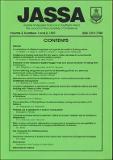| dc.contributor.author | Bryant, MJ | |
| dc.contributor.author | Sibanda, L.M. | |
| dc.contributor.author | Ndlovu, L.R. | |
| dc.contributor.author | Bryant, M.J. | |
| dc.coverage.spatial | Zimbabwe. | en |
| dc.date.accessioned | 2016-03-07T15:33:48Z | |
| dc.date.available | 2016-03-07T15:33:48Z | |
| dc.date.issued | 1997 | |
| dc.identifier.citation | Sibanda, L.M., Ndlovu, L.R. and Bryant, M.J. (1997) Factors affecting the growth and survival of Matebele goat kids in a semi-arid environment under smallholder management, Journal of Applied Science in Southern Africa, vol. 3, nos.1/2, pp.27-35. Harare: UZ Publications. | en |
| dc.identifier.issn | 1019-7788 | |
| dc.identifier.uri | https://opendocs.ids.ac.uk/opendocs/handle/20.500.12413/9756 | |
| dc.description | A research article on factors affecting effective goat rearing in Zimbabwe's rural areas. | en |
| dc.description.abstract | Performance of 631 kids belonging to seven smallholder farmers in southern Zimbabwe was monitored over a two-year period. Least square mean live weights at 14,150 and 360 days (d) of growth were 4.3 + 0.04,11.5 + 0.11 and 19.9 + 0.19 kg, respectively. Exit rate between birth and 150 days was 35 percent. Live weight at all the three stages of growth and pre-weaning exit rates varied significantly (p<0.001) between birth months and between flocks (p<0.001). Pre-weaning growth rates tended to be relatively faster for kids born between September and January (dry to early wet seasons) but were depressed post-weaning as a result of dry season feed shortages. Consequently, kids born in September-January tended to weigh less at 360 days compared to kids born in February-July. Male kids and singles were significantly heavier (p<0.001) at all ages than female kids and twins, respectively. Age of the doe significantly affected kid weight at 150 d, with kids born to does of 1 to 2 years of age being 13-25 percent lighter (p<0.01) than kids born to older does. Exit rates were highest (33 percent) in July, the month where maximum births occur. Exit rates were significantly higher (p<0.001) in year 1 (52 + 0.22 percent) than in year 2 (48 + 0.31 percent). Kid survival was not influenced by age of the doe, sex or birth type of the kids. It is concluded that growth and survival of Matebele kids could be improved through strategic management of seasonal effects and better understanding of local management. | en |
| dc.language.iso | en | en |
| dc.publisher | University of Zimbabwe (UZ) Publications | en |
| dc.rights.uri | http://creativecommons.org/licenses/by-nc-nd/3.0/ | en |
| dc.subject | Agriculture | en |
| dc.subject | Rural Development | en |
| dc.title | Factors affecting the growth and survival of Matebele goat kids in a semi-arid environment under smallholder management | en |
| dc.type | Article | en |
| dc.rights.holder | University of Zimbabwe (UZ) | en |


